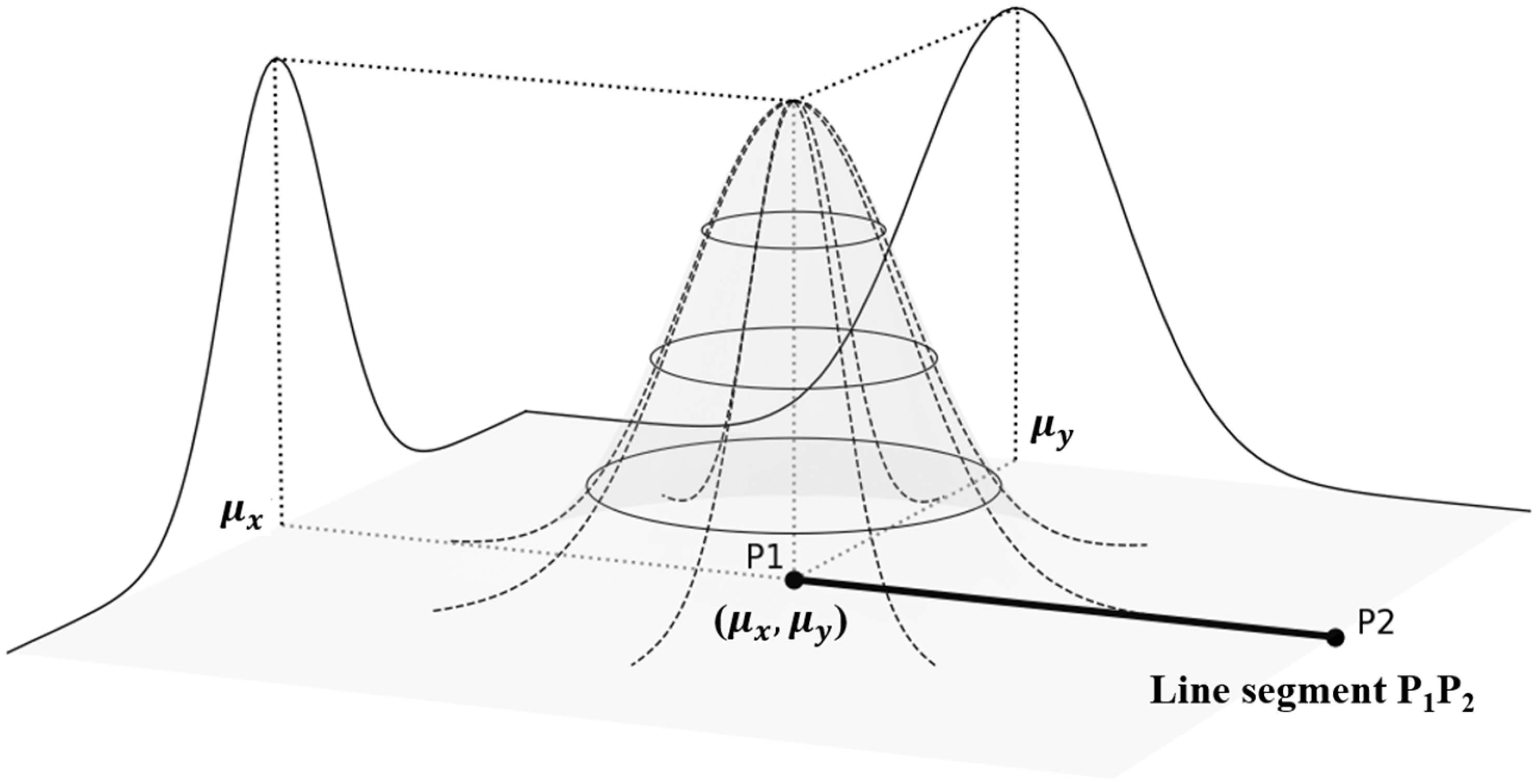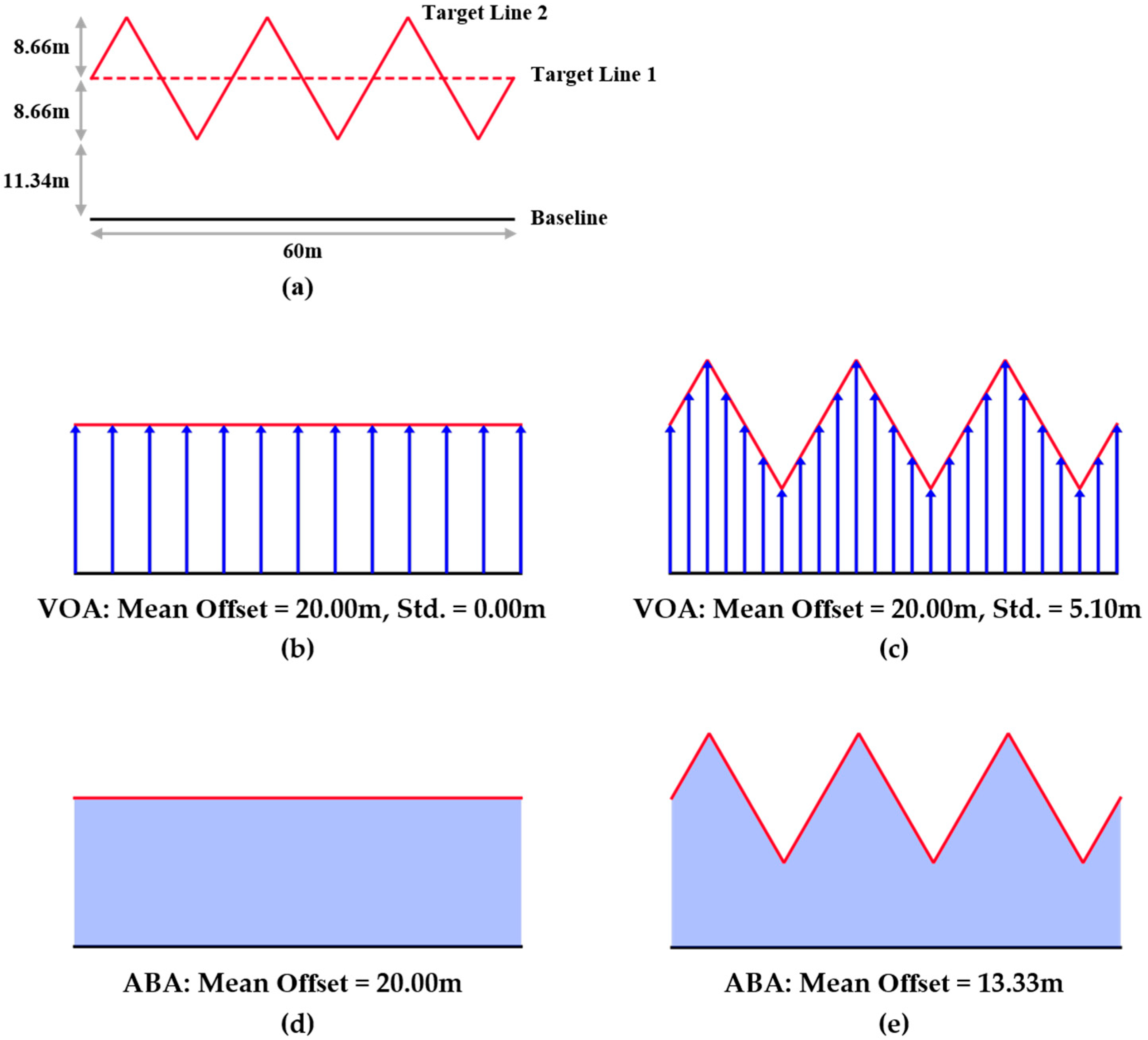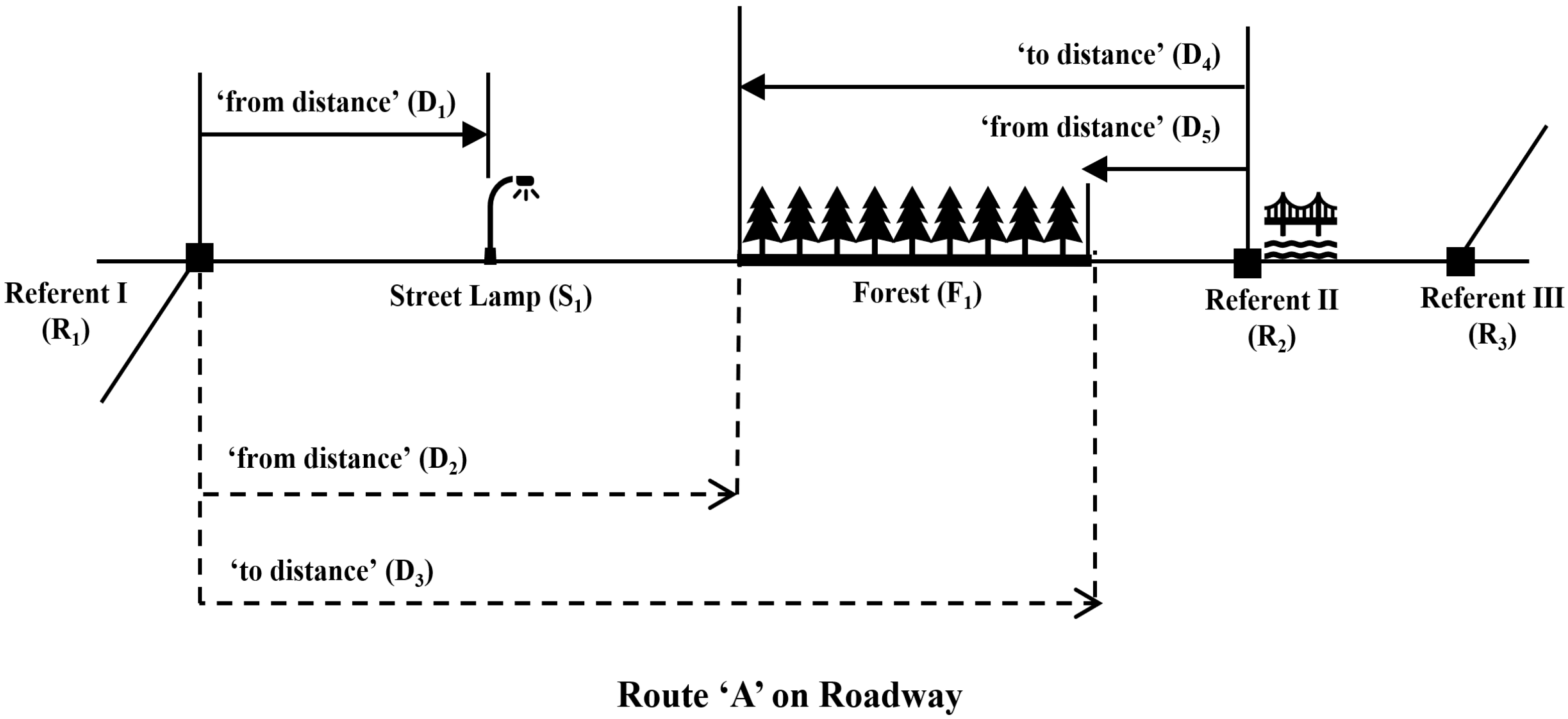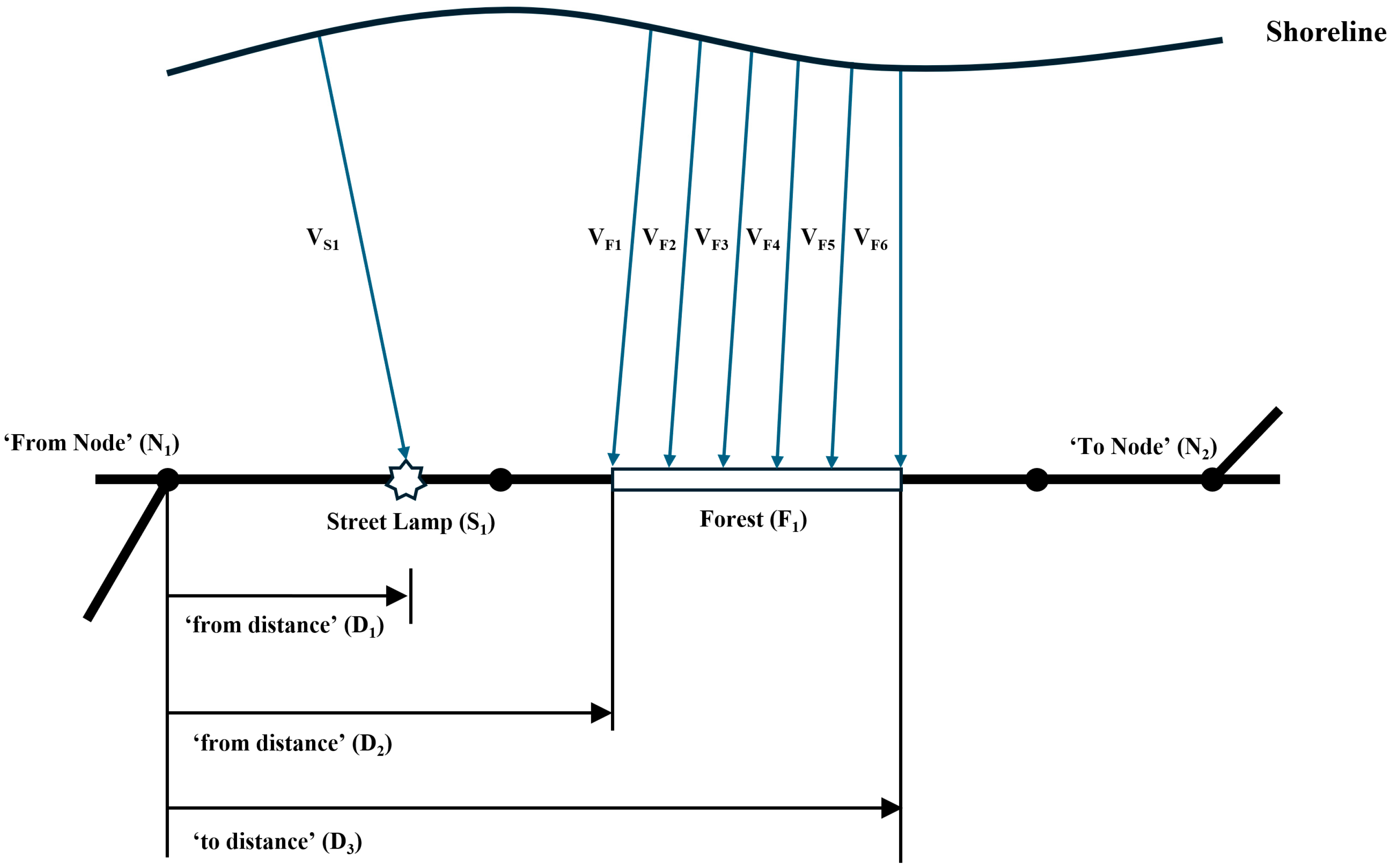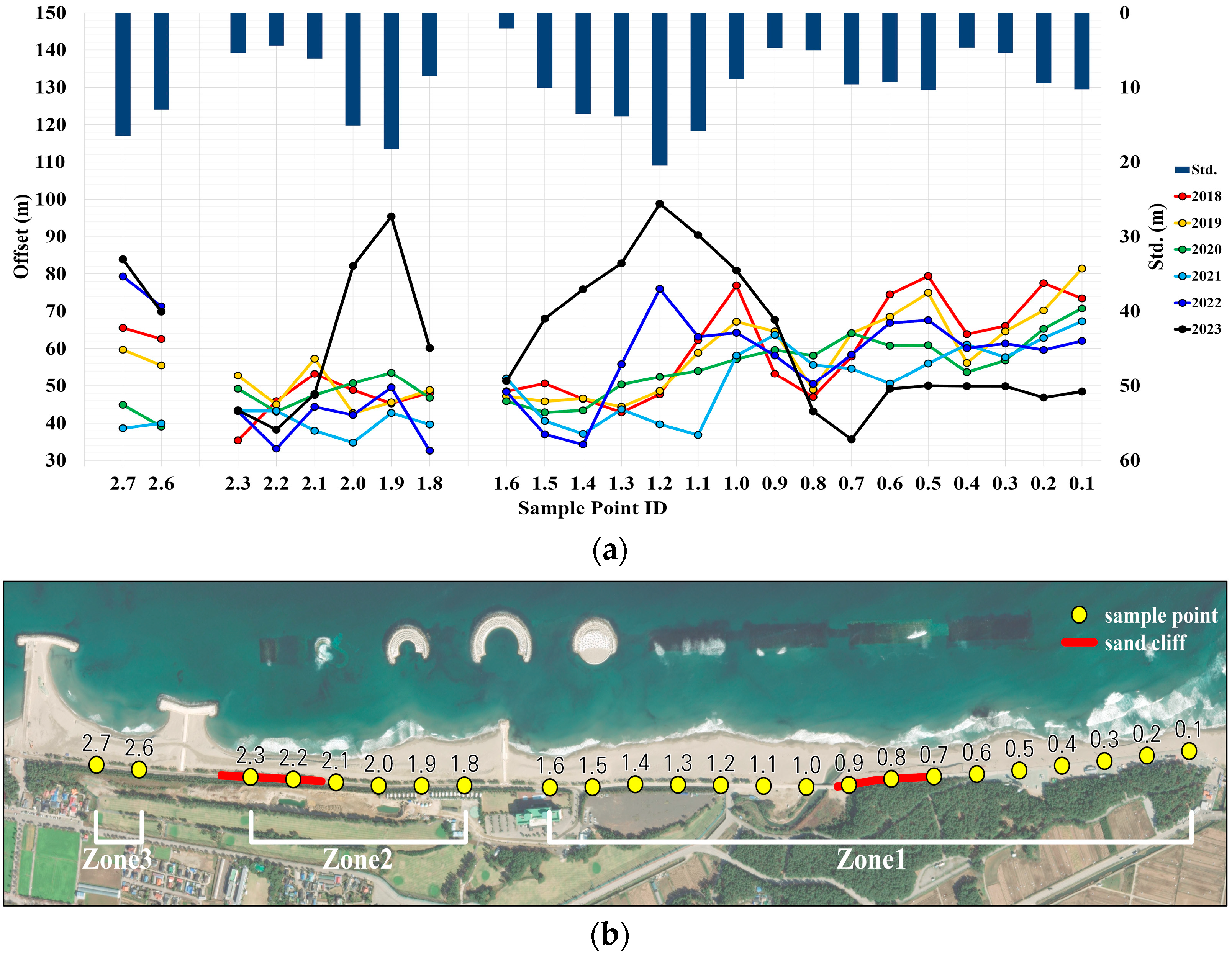3.3. Implementation of LRS-Based Linear Referencing with VOA Method
In the LRS-based linear referencing method, a referent is a basis for determining linear locations along roadways. Referents must be unique and known locations to enable people to easily identify and record the locations of roadway assets and facilities. The Maengbang coastal roadway is a straight roadway along the shoreline, intersecting with other roadways for local access (
Figure 11a). Also, some of the streetlamps installed at regular intervals are assigned unique identification numbers (IDs) and designated as report spots, allowing for the efficient location identification and incident reporting in the event of criminal, traffic, or maritime emergencies (
Figure 11b). Therefore, in this study, roadway intersections and reporting spots are designated as referents to determine specific positions of erosion-susceptible sections (e.g., sand cliffs) and infrastructures (e.g., erosion control structures) along the coastal roadway.
A roadway spatial database in
Table 3 shows the linear locations of referents along the Maengbang coastal roadway. The referents include three roadway intersections and ten report spots. The ‘from distance’ indicates the linear location of each referent, starting from the intersection at the entrance of Maengbang Beach (Referent ID 1, at 0.0 m). Referent IDs 2 through 11 correspond to reporting spot IDs 1 through 10. The remaining two referents (Referent IDs 12 and 13) represent intersections located near major landmarks, such as the Maengbang golf course and the detached breakwater.
The referents were used to identify and locate roadways susceptible to shoreline erosion. Along the coastal roadways, vegetated buffer zones were created to protect the roadway from coastal erosion. However, high waves and strong winds have caused persistent erosion, which weakens the roadbed and negatively impacts the structural stability of the road. As a countermeasure, the local authority conducts annual maintenance activities, including artificial sand replenishment. Therefore, in this study, the linear locations of sand cliffs along the coastal roadway were measured and recorded, as shown in
Table 4 and
Figure 10. The first sand cliff, corresponding to Event ID 1, is located between 8.0 m beyond Referent ID 8 (703.0 m) and 13.2 m before Referent ID 10 (943.8 m). Thus, in
Table 4, the ‘from distance’ is recorded as 711.0 m (703.0 m + 8.0 m), and the ‘to distance’ is recorded as 930.6 m (943.8 m–13.2 m). Also, the second sand cliff extends from 939.9 m beyond Referent ID 12 (1195.8 m) to 496.8 m before Referent ID 13 (2869.3 m). Therefore, the ‘from distance’ was computed as 2135.7 m (1195.8 m + 939.9 m), and the ‘to distance’ is recorded as 2372.5 m (2869.3 m–496.8 m).
Also, to facilitate analysis in the next section, the Maengbang coastal roadway was divided into three distinct analysis zones (Zone 1, Zone 2, and Zone 3), based on the linear locations of erosion control structures along Maengbang beach. These zones are illustrated in
Table 5 and
Figure 10. Zone 1 is the longest section between the starting point and the groin, extending linearly from 103.0 m to 1602.7 m along the coastal roadway. Zone 2, situated between the groin and the breakwater, is a 500-m section extending from 1802.7 m to 2302.7 m. Finally, Zone 3, situated between the two breakwaters, encompasses a 100-m section, with its linear location defined from 2564.5 m to 2664.5 m. In GIS, the LRS-based linear referencing is integrated with the roadway centerline map at a 1:5000 scale, along with historical shoreline data from 2018 to 2023, as shown in
Figure 10. Both the roadway centerline map and shoreline datasets were obtained from the spatial data infrastructure managed by South Korea’s central government. The scale of the roadway centerline map is 1:5000 and its positional accuracy of 1.5 m RMSE. Also, the shoreline datasets were extracted from aerial orthophotos with a spatial resolution of 0.25 m, ensuring a high level of detail for shoreline delineation. Shorelines are inherently variable due to seasonal factors such as tidal fluctuations, wave activity, precipitation, and atmospheric pressure. The eastern coast of Korea is predominantly characterized by semi-diurnal tides with a relatively small tidal range of approximately 20 cm [
38,
39]. Also, when concerning the meteorological conditions, the significant wave heights tend to peak in January and December, while reaching their lowest levels in May and June [
40,
41,
42]. However, sea level variability tends to increase from June to August due to changes in sea surface temperature and atmospheric pressure [
43]. In this regard, shoreline data from March to May, which represent a transitional period following the dissipation of winter storm waves and preceding the onset of summer typhoons and heavy rainfall season, were selected to minimize short-term fluctuations and enhance the stability of analyze a long-term patterns of shoreline change.
3.4. Application and Result
Vector offsets between the coastal roadway and each historical shoreline were measured to assess the annual vulnerability of the coastal roadway.
Table 6 shows the annual changes in shoreline positions at 100 m intervals of sample points along the roadway. In 2018, the mean offset and its standard deviation were 57.2 m and 12.4 m, respectively. Following the construction of a thermal plant and its berthing facility in late 2018, the shoreline retreated, reducing the mean offset to 48.2 m by 2021. In 2022, the trend reversed as erosion control structures were constructed, and in 2023, the mean offset increased to 62.9 m, with a further increase in standard deviation to 18.9 m. The continued increase in standard deviation since 2021 indicates spatially heterogeneous deposition, with sediments not being distributed uniformly but rather concentrated in specific sections.
The point-specific offset analysis was followed to identify erosion-susceptible sections of the roadway. In
Figure 12a, the ID of each sample point on the
x–axis corresponds to its linear distance in kilometers from the starting point of the roadway. The left
y–axis represents the annual mean offset, while the right y–axis indicates the standard deviation of all annual offsets. Also, in
Figure 12b, the aerial photo illustrates the spatial locations of the sample points along the coastal roadway. This analysis shows that 14 out of 24 sample points experienced shoreline accretion between 2018 and 2023, resulting in a reduction of roadway vulnerability across approximately 58% of the coastal roadway. Specifically, the roadway sections from sample point ID 1.1 to ID 1.5, from ID 1.9 to ID 2.0, and at ID 2.7 exhibited notable increases in the mean offsets in 2022 and 2023, accompanied by higher standard deviations exceeding 10 m. These results imply not only increased sediment accumulation, but also spatial variability has occurred due to local topographic conditions or infrastructure interventions. In contrast, despite the erosion control structures, some roadway sections continued to experience shoreline erosion. For example, the roadway section from sample point ID 0.1 to ID 0.8 remained stable from 2018 to 2022, but a sharp decline in mean offset was observed in 2023. This implies that the erosion control structures may have limited spatial effectiveness.
For a more detailed assessment at the local scale, sub-analysis zones with greater shoreline variability were selectively defined, and vector offsets were measured at 10-m intervals. In Zone 1, three sub-analysis zones, which are Zone 1-A, Zone 1-B, and Zone 1-C, were defined for the annual offset analysis in
Table 7 and for the point-specific offset analysis in
Figure 13. The overall trends of shoreline changes indicate that Zones 1-B and 1-C have shoreline accretion, whereas, Zone 1-A has a continuous shoreline recession despite the presence of the erosion control structures. In
Table 7, shoreline distances in Zone 1-A remained relatively stable from 2018 to 2022, with mean offsets exceeding 58.3 m in most years, except for 2021. However, in 2023, the mean offset sharply decreased due to the construction of detached and submerged breakwaters in 2022 and 2023. Intensified wave activity caused shoreline erosion between sample point IDs 0.71 and 0.93, resulting in the formation of sand cliffs and increased roadway vulnerability in
Figure 13.
The coastal roadways in Zone 1-B and Zone 1-C, adjacent to the detached and submerged breakwaters, each span approximately 200 m (
Figure 13b). In
Table 7, Zone 1-B exhibited greater variation in both mean offsets and standard deviations compared to the other sub-analysis zones. Between 2018 and 2021, the mean offset decreased from 56.0 m to 40.0 m. However, following the construction of submerged breakwaters in 2022, rapid sediment deposition increased the mean offset to 93.3 m by 2023, indicating reduced roadway vulnerability. In Zone 1-C, the mean offset consistently decreased from 2018 to 2022. In
Table 7, the mean offsets between 2021 and 2022 were below 40 m, indicating high roadway vulnerability. However, in 2023, shoreline accretion between sample points ID 1.35 and 1.50 resulted in a 32.8 m increase in the mean offset, reaching 71.0 m. Also, the standard deviation sharply rose to 7.4 m. Similar to Zone 1-B, this shoreline accretion is attributed to the submerged and detached breakwaters, leading to reduced roadway vulnerability.
The coastal roadway in Zone 2-A includes sand cliffs along the shoreline (
Figure 14b). According to
Table 8, the mean offset increased from 48.0 m in 2018 to 49.4 m in 2019, even though construction of the thermal power plant began in late 2018. However, after the breakwater was built in 2021, the mean offset sharply decreased to 39.0 m, indicating that the roadway became more vulnerable. In 2023, the mean offset rose to 55.5 m, which implies that shoreline accretion occurred due to the detached breakwaters constructed in 2022. Nevertheless, the high standard deviation of 19.7 m implies that shoreline accretion was spatially irregular along the roadway. The point-specific analysis in
Figure 14 confirms that significant shoreline accretion was observed around sample point ID 2.0, resulting in a standard deviation exceeding 10 m. In contrast, for the remainder of the roadway, relatively limited shoreline accretion was observed with a standard deviation below 10 m. Also, the sand cliffs between ID 2.14 and 2.37 appear to have contributed to persistent vulnerability. In Zone 3-A, the roadway between the two breakwaters extends from sample points ID 2.60 to 2.70. As shown in
Table 8, the mean offset dropped from 68.5 m in 2018 to 37.5 m in 2021, indicating significant shoreline erosion. However, in 2023, the mean offset increased to 74.3 m, reflecting a reduction in roadway vulnerability.
Figure 14 also illustrates that geomorphological changes followed the construction of breakwaters between 2021 and 2023. Each sample point recorded a standard deviation exceeding 13 m. Concentrated wave energy between the breakwaters likely accelerated erosion from 2019 to 2021, but the completion of the structures and beach nourishment appears to have mitigated this effect, promoted shoreline recovery and improved road stability.


